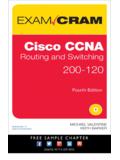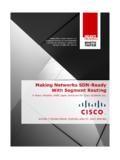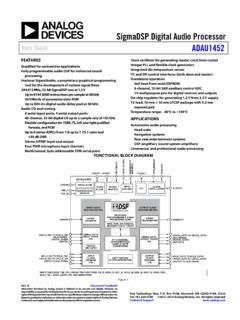Transcription of Comparison of RIP, EIGRP, OSPF, IGRP Routing …
1 IOSR Journal of Computer Engineering (IOSR-JCE) e-ISSN: 2278-0661,p-ISSN: 2278-8727, Volume 16, Issue 4, Ver. VI (Jul Aug. 2014), PP 57-64 57 | Page Comparison of RIP, eigrp , OSPF, IGRP Routing Protocols in Wireless Local Area Network (WLAN) by using OPNET Simulator tool - A Practical Approach P. Kalamani1, M. Venkatesh Kumar2 , M. Chithambarathanu3, Reji Thomas4 1(Asst. Professor, Dept. of CSE, Shirdi Sai Engineering College, Bangalore, India) 2(Sr. Lecturer, Dept. of CSE, Shirdi Sai Engineering College, Bangalore, India) 3(Asst. Professor, Dept. of CSE, Shirdi Sai Engineering College, Bangalore, India) 4(Sr. Lecturer, Dept. of CSE, Shirdi Sai Engineering College, Bangalore, India) Abstract: In Adhoc Network group communication is more important, in which Routing protocols play a vital role for data transmission. With/Without using central server or access point, the Wireless network form a temporary network with collection of wireless nodes in which, each node changes randomly at different times.
2 In order to establish data transmission between nodes, multiple hops are needed because of limited range transmission rate. In this paper, we have analyzed and simulated a proposed Wireless Local Area Network (WLAN) using different Routing protocols. The performances of different protocols are compared and analyzed using Optimum Network Performance (OPNET) simulator tool in which metrics like delay, throughput, packet delivery, load, Ethernet delay, are measured. Keywords: Adhoc Networks, OPNET, WLAN, RIP, OSPF, IGRP, eigrp , Routing protocol I. Introduction Nodes communicate with one another by using multi-hop wireless link in Adhoc networks. Routing plays an important role of moving the data from source to destination takes place in the network layer of Open System Interconnection (OSI) reference model. Routing is divided into two techniques Static Routing and Dynamic Routing [3], [5].
3 In static Routing , the Routing is done manually, whereas in the dynamic Routing , the Routing it is an interior and exterior Routing protocols. Wireless Local area network provides high speed data transmission which can be accessed from any location. Applications like video conferencing, voice chatting, file transferring can be done in Wireless Local Area network with high transmission speed [1], [7]. In this paper, a Wireless Local Area Network (WLAN) is designed and various Routing protocols like Routing Information protocol (RIP), Enhanced Interior Gateway Routing protocol ( eigrp ), Open Shortest Path First (OSPF), and Interior Gateway Routing protocol (IGRP) are used and compared for testing the performance [9]. II. Literature Survey Performance analysis of Wireless Local Area Network (WLAN) was performed by using OPNET simulator earlier through delivery traffic.
4 Several authors have given suggestions how to improve the performance increasing the buffer size. Using high priority traffic, throughput of Wireless Local Area Network (WLAN) is evaluated [5]. In this section, we summarize the basic procedure assumed in multicast protocols and then the Adhoc Routing protocols are proposed in the literature survey. Multicast protocols which include the tree-based protocol and mesh-based protocol in which the tree based protocols construct a tree structure for forwarding the packets more efficiently among the neighbors. The work in [2], [3], attempts to improve the transmission data over a large network without any link breaks. As the focus of our approach, a Comparison with Routing protocols for Adhoc networks is done by using OPNET simulator tool, so that the performance metrics like packet delivery, delay and throughput are measured for a large network [6].
5 The HRPM [5] and SPBM [7] are more related work in which the design ideas like decomposition of large groups and distributed geographic hashing to construct a table for better data transfer. Different from general multicasting, the destination are groups of receivers to which all the destinations receive the packet with constant rate depending upon the various Routing protocols [9]. III. Routing Protocols In computer networks, the Routing protocol specifies how routers communicate to select the routes for information or data transfer for that, the Routing algorithm is more important [7]. First, the Routing protocol informs or shares the information with their associative neighbors and then throughout the network, in which topology is determined [5] [10]. Different types of Routing protocols are as follows, OSPF & IS-IS-> Interior gateway Routing using link state Routing protocol Comparison of RIP, eigrp , OSPF, IGRP Routing Protocols in Wireless Local Area Network 58 | Page RIP & eigrp -> Interior gateway Routing using Distance vector Routing protocol BGP -> Exterior gateway Routing using path vector Routing protocol Routing Information protocol (RIP) RIP stands for Routing Information protocol in which distance vector Routing protocol is used for data/packet transmission.
6 In Routing Information protocol (RIP), the maximum number of Hop is 15, because it prevents Routing loops from source to destination. Mechanism like split horizon, route poisoning and holdown are used to prevent from incorrect or wrong Routing information. Sally Floyd and Van Jacobson [1994] suggest that, without slight randomization of the timer, the timers are synchronized overtime [6]. Compared to other Routing protocol , RIP ( Routing Information protocol ) is poor and limit size small network. The main advantage of using RIP is it uses the UDP (User Datagram protocol ) and reserved port is 520 [10]. Enhanced Interior Gateway protocol ( eigrp ) eigrp stands for Enhanced Interior Gateway protocol which allows router to share information to the neighboring routers which are within the same area. Instead of sending the entire information to the neighboring router, the information which is needed are shared which reduces the workload and amount of data needs to be transmitted.
7 eigrp (Enhanced Interior Gateway protocol ) designed by CISCO system which can be used only in CISCO routers, but in 2013 it became open source, so it can be used in other routers [5] [7]. Neighbor table and Topology table are maintained by the eigrp (Enhanced Interior Gateway protocol ) [10]. Open Shortest Path First (OSPF) OSPF stands for Open Shortest Path First which uses link-state Routing algorithm. Using the link state information which is available in routers, it constructs the topology in which the topology determines the Routing table for Routing decisions [7]. It supports both variable-length subnet masking and classless inter-domain Routing addressing models. Since it uses Dijkstra s algorithm, it computes the shortest path tree for each route. The main advantages of the OSPF (Open Shortest Path first) is that it handles the error detection by itself and it uses multicast addressing for Routing in a broadcast domain [8].
8 Intermediate-System to Intermediate - System (IS- IS) IS-IS stands for Intermediate-system to Intermediate - system which uses link-state Routing algorithm for high speed data transmission. IS-IS (Intermediate-system to Intermediate system) uses Dijkstra s algorithm in which independent database built by each IS-IS router for computing the best path for transmission in a network. It is standardized by ISO, but later IETF (Internet Engineering Task Force) standardized as the Internet Standard in RFC 1142 [3], [6], [10]. Interior Gateway Routing protocol (IGRP) IGRP stands for Interior Gateway Routing protocol which uses distance vector protocol (interior) to exchange data within a system [4]. It supports multiple metrics for each node which includes delay, load and bandwidth, in order to compare the 2 routes which are combined into single metrics.
9 The port number for IGRP is 9 which are used for communication and by default every 90 seconds it updates the Routing information [5]. Comparison of Routing Protocols "Table." 1 Comparison of Routing protocols Comparison of RIP, eigrp , OSPF, IGRP Routing Protocols in Wireless Local Area Network 59 | Page IV. Performance Metrics End to End Delay -> Sum of the node delay at each node + link delay at each link on the path (1) Throughput -> Total size of packets received at destination nodes which measured in Kbps (kilo bits per second) Packet delivery -> Ratio of data packets delivered to the destination generated by CBR. (2) Routing -> Ratio of Routing protocol to the total number of packets generated by the source. (3) V. Experimental Setup And Result Analysis In this paper, the proposed network has been simulated by using OPNET simulator tool and the performances of different Routing protocols were analyzed.
10 Components for the network design, WLAN parameters and profile configuration parameters are used in our experiment are shown in table 1, table 2 and table 3 respectively. The performance like load, delay, throughput for various protocols were taken and analyzed. COMPONENT MODEL Application Configuration Application Config Profile Configuration Profile Config Ethernet Server Ethernet Server Connection 10 BaseT connector Access Point Wlan_ethernet_router Nodes Wlan_wkstn_adv protocol RIP, eigrp , IGRP, OSPF Table. 2 Components for the network design ATTRIBUTE VALUE BSS Identifier Auto Assigned Access Point Functionality Enabled Buffer size (bits) 256000 Data rate (bps) 1 Mbps, 11 Mbps Table. 3 WLAN parameters ATTRIBUTE VALUE Profile Configuration Profile Config Profile name Web application, Wireless application Operation mode Serial (ordered) Start time Uniform(100,110) Duration End of Simulation Repeatability Once a start time Table.

















